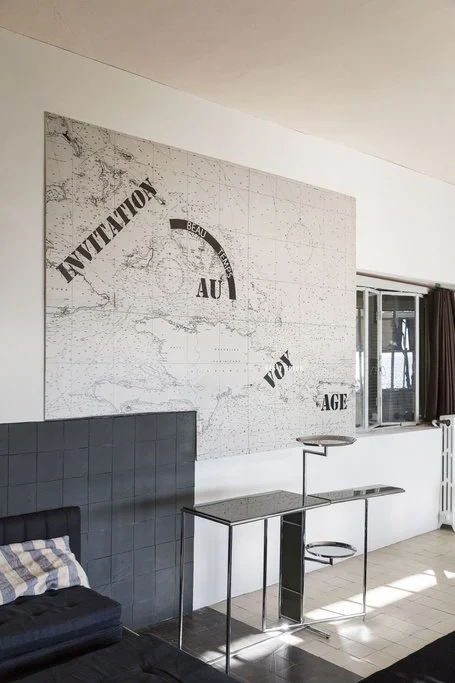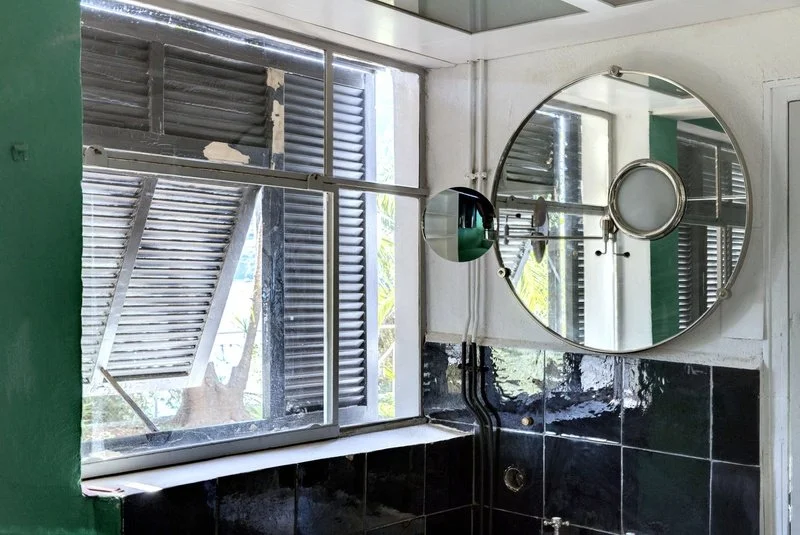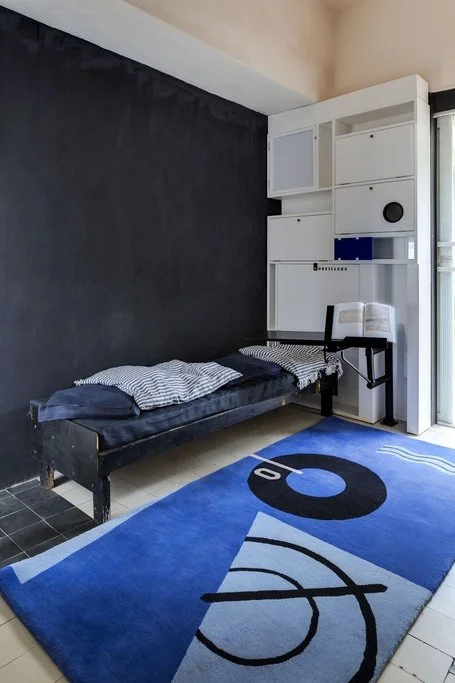EILEEN GRAY - THE BUSINESS OF DESIGN
by Lizzie Broadbent
The design and build of E-1027 has rightfully earned Eileen Gray a place in the history of architecture. The story of its creation, defacement, its deterioration and renewal is compelling and it gives us a memorable lead in Eileen, the modernist, a woman in a man’s world, forging a lonely path as she works in new materials and challenges the status quo to realise a deeply personal project.
This image is a fair representation of Eileen at that point in her life. As a result of her landmark project she pressed pause on her Parisian life and closed her commercial venture. She then struggled to find her place in the unwelcoming world of architecture and focused on her own projects.
However, an examination of her life BC (Before Corbusier) gives a different incarnation of Eileen: a woman who was well-networked, collaborating with and supporting other women and showing her work with the aim of selling it.
© Rights reserved E. Gray and J. Badovici rights holders - Photo by Manuel Bougot
NETWORKED
Eileen started her career at the Slade School of Art in London, where she studied between 1900 and 1902. She is often described as one of the first women to be admitted. This fits the isolated pioneer narrative. But it is not true.
In fact, the Slade celebrated its 30th anniversary while Eileen was a student and had been open to men and women right from the start. Women who had gone before her included Evelyn de Morgan, Gwen John and a fellow Irish woman, Constance Gore-Booth, later Markiewicz, who in 1918 became the first woman to win a parliamentary seat. Of the 228 pupils in Eileen’s class, 168 were women. A photograph from 1905 shows a few men in grey suits adrift in a sea of white dresses and a froth of hats.
While the Slade might not have met Eileen’s artistic and educational needs – she was frustrated with the curriculum and her attendance was irregular – it gave her the basis for a network in the arts and set her on the path to Paris, the city that would become her home. She was in good company: many students decided to continue their studies there and she crossed the Channel with two classmates, Kathleen Bruce, already making her name as a sculptor, and Jessie Gavin, who became a lifelong friend.
© Rights reserved E. Gray and J. Badovici rights holders - Photo by Manuel Bougot
COLLABORATIVE
In 1907, two more women entered Eileen’s life. Evelyn Wyld (1882-1973), American by birth, was a long-time friend of Eileen’s sister, Thora, and had known Eileen since childhood. Encouraged by her friend, Kate Weatherby (1881-1964), she was beginning to explore the craft of rug weaving. Eileen was already studying the craft of lacquerware under Seizo Sugawara. Some artists were starting to explore rug design and Eileen saw this as another area where should could combine art and craft.
In 1908-9 she and Evelyn travelled together to Morocco to learn techniques of weaving and wool dyeing. On their return, Evelyn went to London to continue her studies. She came back to Paris bringing with her equipment acquired from the London School of Weaving and one of its teachers to help them set up their own operation.
Eileen and Evelyn found space for their workshop in a building around the corner from Eileen’s flat in the sixth arrondissement and started making hand-knotted carpets. The majority of the rugs bore the label ‘Designed by Eileen Gray at the workshop of Evelyn Wyld’ although Evelyn also made her own designs. Their work was interrupted by the war but by 1924 was significant in size, spread across three floors where eight women worked on three different kinds of loom.
© Rights reserved E. Gray and J. Badovici rights holders - Photo by Manuel Bougot
ENTREPRENEURIAL
As well as designing rugs, Eileen was designing and making lacquerware and in 1913 was invited to show her screens at the Salon de la Société des Artistes Décorateurs. She immediately attracted the attention of discerning collectors, including Jacques Doucet, the king of French fashion. In 1914. She started to take commissions to make other pieces of furniture. After the war, she began taking larger interior design commissions and in 1922, she decided to venture further into the commercial sphere by opening a store.
Cards and invitations, designed by sculptor Chana Orloff, read ‘Furniture, Lacquerwork, Screens, Carpets by Eileen Gray’. At the top was the name of the shop: Jean Désert.
Why did Eileen decide to put an invented man’s name over her newly-designed, elegant store front, rather than her own? It was not for an absence of role models. She would surely have seen other women doing just this when she was a student in London. The Slade School of Art was part of University College and stood at the north end of Gower Street. Further down the same street were two prominent businesses set up by women. Alice Hughes had her photography studio at no. 52. Further south at no 2 was ‘R & A Garrett House Decorators’, founded by Rhoda and Agnes Garrett in 1876.
After the war, more women in London took the plunge. As Eileen was launching her business, Syrie Maugham, ex-wife of the writer Somerset Maugham, was opening her eponymous interior design shop in London. That same year, David and Betty Joel launched their furniture business under Betty’s name.
Perhaps it was too radical a move in a country where women were still fighting for the vote and an unappealing one for a woman who valued her privacy. Eileen could still have invented a woman’s name. Juliette Mathieu-Lévy, an important interiors client, owned a fashion house and millinery shop bearing the imaginary name of J. Suzanne Talbot. However, in the end, what Eileen needed for the business to succeed was customers. She could well have thought that passers-by on Rue du Faubourg Saint-Honoré would be more likely to cross the threshold of a business run by a man.
This rationale would still have made sense six decades later. In 1982, viewers tuned in to a new TV series, ‘Remington Steele’, about a (female) private detective who, struggling to attract clients, re-branded with the name of an invented (male) boss. It ran for five years. Even today women still write books under men’s names or disguise their gender with initials. Many companies now remove the names from CVs altogether before they start the review process.
If mitigating gender bias was the reason for Eileen’s decision, it wasn’t enough to ovecome suspicion of the radical work on show. The rugs that Eileen made with Evelyn were an exception. They came in different sizes and colours and, significantly, price points. Analysis of the ledger for the period from 1923 to 1927 shows that they accounted for 50% of the total revenues and brought in twice as money as Eileen’s furniture. Their significance is evidenced by Eileen’s decision in 1926 to transfer half the looms from the workshop to the basement of the showroom and begin paying the salaries of two or three women weavers.
© Rights reserved E. Gray and J. Badovici rights holders - Photo by Manuel Bougot
CHAMPIONING
Eileen offered space at Jean Désart to other artists to show their work. It was here that Chana Orloff, who also designed cards, invitations and letterheads for the store, had her first solo exhibition. She displayed her woodcuts alongside furniture designed by Eileen.
Eileen’s mentoring went beyond the gallery. At around the time of the shop opening, she was introduced to the Irish artists Mainie Jellett (1897-1944) and Evie Hone (1894-1955), who were living and working in Paris. The influence of Eileen on Maine’s work can be clearly seen in her shift into the decorative arts. In 1927, Maine designed a rug made by Evelyn in the Rue de Visconti workshop and incorporated them into her practice for the next ten years.
© Rights reserved E. Gray and J. Badovici rights holders - Photo by Manuel Bougot
FROM PUBLIC TO PRIVATE
By 1927 Eileen was deeply enmeshed in her relationship with Badovici and focused on the design and construction of E-1027. Evelyn was still occupying the Rue de Visconti workshop but was now using the looms to make the designs of her new partner, Elizabeth Eyre de Lanux. These rugs were not sold through Jean Désart and the shop did very little business after 1927. Large amounts of stock had to be sold off at hefty discounts before the shop could be formally closed in 1930. Eileen felt only relief - the business had been hard work and ultimately unprofitable.
If Eileen had been prepared to put more effort into building her brand or had found a partner to manage the commercial and administrative side of the business, perhaps the shop might have been more successful. However, when it comes to her legacy, it might still have been one of the best things she did. In 1932, Eileen left Jean Badovici and E-1027. From that point on, everything she built was for her own use. Plans for other projects remained on paper only. She did not exhibit at any Salons or take any private commissions. She sketched designs for rugs but did not make them. The house she moved to in 1932 was severely damaged in the Second World War, along with its furnishings. If she had not decided to open the shop and make rugs and furniture to fill it, there would be even less to see that there is now.
Lizzie Broadbent is the founder of Women Who Meant Business, an ongoing project that celebrates the accomplishments of pioneering businesswomen born in the Victorian Era. For regular updates, subscribe to the Women Who Meant Business Substack.
Note: The National Museum of Ireland has a permanent exhibition honouring the life and work of Eileen Gray. The National Gallery of Ireland has a major exhibition, Mainie Jellett and Evie Hone: The Art of Friendship, which runs until 10th August. The Guildhall Art Gallery in London has an exhibition Evelyn De Morgan: The Modern Painter in Victorian Britain, on until 4th January 2026.
Sources:
Adam, Peter (2019) Eileen Gray: Her Life and Work, Thames and Hudson.
Benton, Tim. (2021). Eileen Gray’s Jean Désert showroom 217 Rue du Faubourg Saint-Honoré, Paris; marketing design in the 1920s Cahiers de la recherche architecturale, urbaine et paysagère.
Goff, Jennifer (2015) Eileen Gray: Her Work and Her World, Irish Academic Press.





